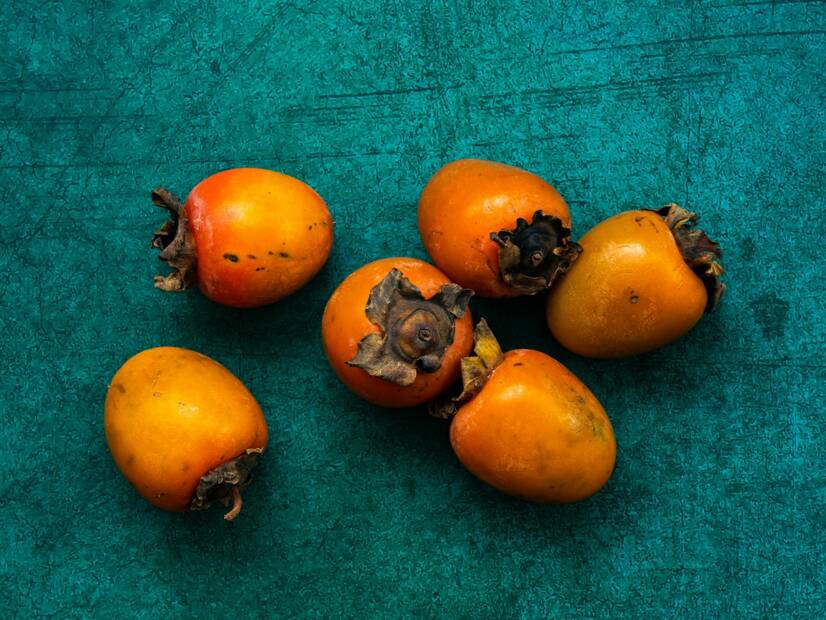Hurmikaki and its health effects. How to eat or grow it?

Hurmikaki fruit grows on trees and originates from China. Hurmikaki is very popular in Japan and can be enjoyed in European countries as well. It is full of vitamins and minerals that are beneficial for our body.
Characteristics
It grows on trees of smaller size, the smaller species can be considered more like shrubs. The larger ones can grow up to 15 metres high.
The fruits, weighing 100-500 g, are orange to reddish in colour with a very thin skin which is edible.
It is similar in appearance to an orange tomato, but when cut open the inside is not so tomato-like.
The flesh is soft to silky, slightly gelatinous, like jam. The taste is sweet, similar to banana, melon and apricot, with a carrot flavour.
Harder fruits with a bitter to astringent taste may also occur. In this case, the fruit is unripe.
However, unripe fruit can also be useful, for example, in diarrhoea. The tannins contained in such unripe fruit are useful in this case.
The fruit contains similar grains to a pumpkin. Here, however, there are 4 to 8 of them and they can be easily removed or even safely eaten.
It is sweetest and tastiest when properly ripe.
Internal use
Fresh hurmikaki can also be used in healthy cakes, juicy desserts and fruit tarts.
It can also be enjoyed by slicing it into cakes or freshly baked pastries instead of jam. It can also be made into jam or dried and eaten as such.
Eating hurmikaki can only improve your mood. Although it has a few limitations, probably like everything, too much of everything is bad for you. It is not good to overdo it either, even though it is really good for your body.
It is also not recommended to consume it on its own in the morning and on an empty stomach, as it can be quite laxative. It is best to consume it as a supplement to your regular diet.
It is ideal during a diet, as it drives away hunger and satiates. At the same time, it replenishes energy and all the necessary vitamins and minerals.
Hurmikaki is rich in vitamins like A, B, C, especially niacin and riboflavin. Among minerals, it contains potassium, magnesium, manganese, copper, sodium, calcium and iron.
Among the very beneficial substances obtained from this fruit are beta-carotene or antioxidants, flavonoids, acids and fibre.
Hurmikaki is a great helper in the fight against cancer and cancer-causing cells.
The calcium will strengthen our bones and the fiber will improve our digestion. Regular consumption of hurmikaki can serve for regular and trouble-free bowel movements.
These substances will also serve in lowering cholesterol, weight loss and help the body to get rid of pollutants.
It is especially popular in the autumn season as it ripens around September and October. During this period, it will help us fight against flu and strengthen our body and immunity.
Hurmikaki can also be indulged in by pregnant women, who will also get the necessary magnesium thanks to it.
Magnesium is needed by both mother and fetus, it helps in preventing cramps and even prevents the risk of miscarriage.
Magnesium is also needed for peace of mind and psychological well-being. Hurmikaki can help prevent neuroses, heart disease or Alzheimer's disease.
Thanks to iron, it can give us protection against anaemia.
External use
Just mix the ripe fruit with a little olive oil and one or two egg yolks, and you have a facial mask.
Such a fruit mask will help slow down aging, refresh the skin and revive problem areas.
A properly ripened hurmikaki will also help with sunburnt skin. If you've been sleeping in the sun or have underestimated sunscreen, try a mask with this fruit.
Mix ripe and soft hurmikaki with white yogurt or sour cream and rub the mixture on irritated skin.
Harvesting and storage
We can speed up ripening by adding apples or bananas to the hurmikaki. These speed up ripening by releasing gas.
Store them dry and at room temperature.
It's best to let them rest for at least a week. We recommend turning them once every day or two so they don't get too soft in one place.
The same applies if they are taken directly from the tree. The fruit is allowed to ripen, then washed thoroughly and eaten.
How to grow hurmikaki?
Hurmikaki trees can be found in temperate regions, although they are quite difficult to grow.
The ebony tree from which the hurmikaki fruit comes is sensitive to frost and cold.
So if you buy this tree and plant it in your garden, do so in the spring and cover it in winter to protect it from frost. This protection is necessary for at least three years after planting.
The soil under the tree must also be cared for. It must have sufficient nutrients and humus or moisture.
It should also be covered, for example with straw in winter, to protect the roots.










